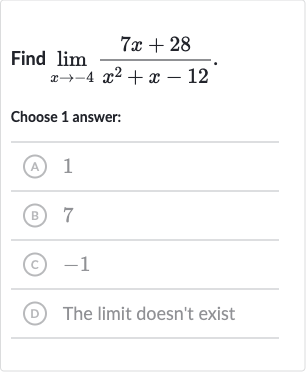Full solution
Q. Find .Choose answer:(A) (B) (C) (D) The limit doesn't exist
- Substitution Attempt: First, let's try to directly substitute the value of into the expression to see if the limit can be evaluated this way.We get an indeterminate form , which means we need to use a different method to find the limit.
- Factoring the Denominator: Since we have an indeterminate form, we should try to factor the quadratic expression in the denominator and see if there is a common factor that can be canceled with the numerator.The quadratic expression can be factored into .
- Rewriting with Factored Denominator: Now let's rewrite the limit expression with the factored denominator and see if we can simplify it. = Notice that is a common factor in both the numerator and the denominator.
- Canceling Common Factor: We can now cancel the common factor from the numerator and the denominator.Now that the expression is simplified, we can directly substitute into the limit.
- Direct Substitution: Substitute into the simplified expression to find the limit.= \frac{}{(())}= \frac{}{()}= We have found the limit, and it exists.

